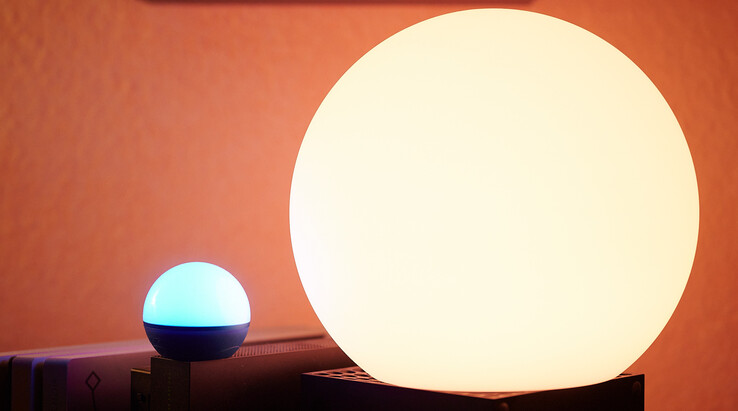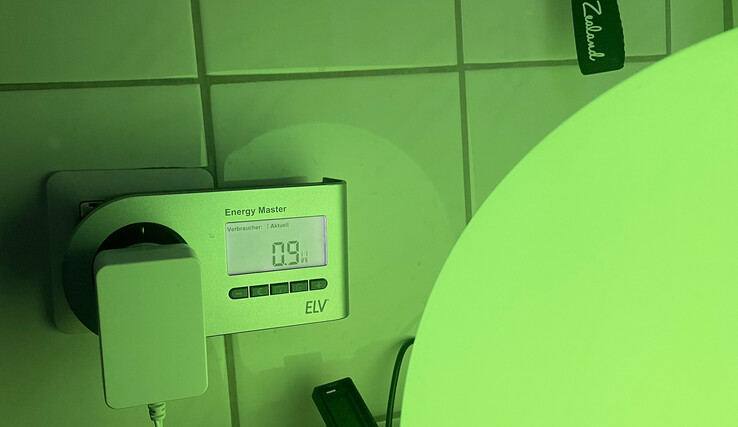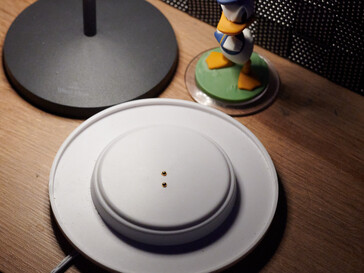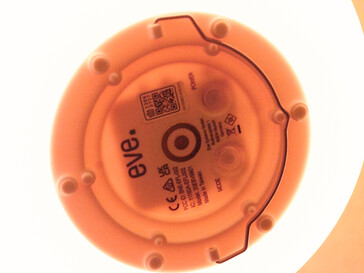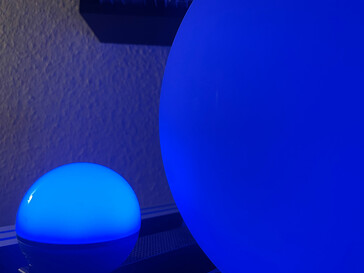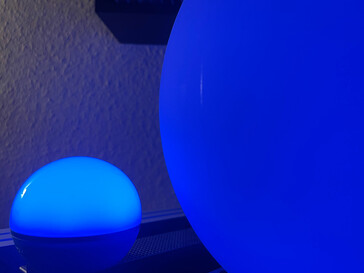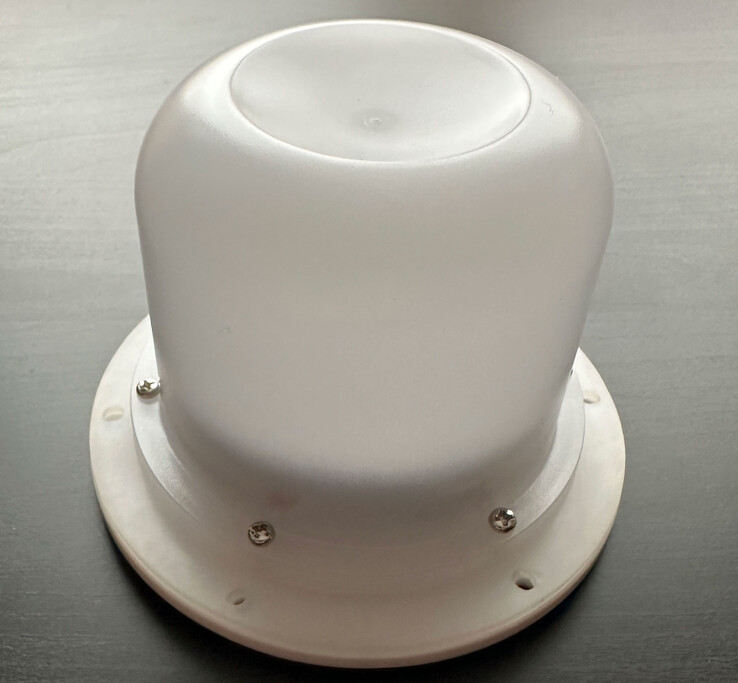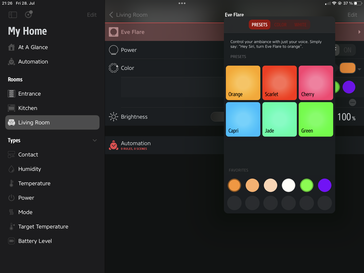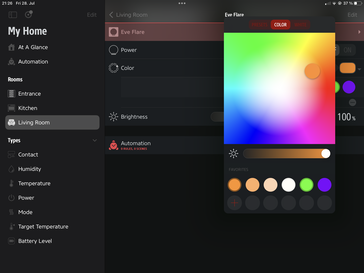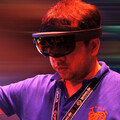The Eve Flare is the smart home manufacturer Eve Systems’ first mood light suited for the thread network. When you first unpack it, the lamp immediately surprises you with its size. With a diameter of 25 centimetres, the Eve Flare is actually even bigger than a size-7 basketball.
In the adverts, its size doesn’t entirely come across well, as Eve Systems often uses an iPhone as a size comparison, whose size can’t be accurately determined at first glance. This means this lamp isn’t suited for bringing with you on your travels.
Within your apartment, however, the lamp can be easily manoeuvred. It even features a handle on the bottom which lets you hang the lamp upside down. Thanks to its integrated battery, you can easily use the Eve Flare throughout the entire evening.
Eve Home has listed the device as having a battery life of 6+ hours, which is under-exaggerated, to say the least. During our tests, we measured a minimum of eight hours. Plus, it should be noted that we even used the power-hungry warm white mode for these measurements.
It turns out that its runtimes are highly dependent on which color you have selected – as we measured in our power tests with a fully-charged battery. The worst case scenario is if you select the warm white color. You can only make estimations on the app, as it doesn’t display the Kelvin values. Set accordingly, the light draws around 2 watts from the mains at maximum brightness. Mind you, this already amounts to 8 hours. The value drops to 0.3 watts when using the minimum brightness.
| Color | Minimum brightness | Maximum brightness |
|---|---|---|
| Warm white | 2 watts | 0.3 watts |
| Cool white | 1.4 watts | 0.3 watts |
| Red | 1.5 watts | 0.3 watts |
| Green | 1 watt | 0.2 watts |
| Blue | 1.5 watts | 0.2 watts |
On the other hand, using a cool white reduces its power consumption. So, if you like this type of vibe, then you can expect slightly longer runtimes, as its power consumption sinks to 1.4 watts. Blue and red also both lie within this area.
Green is particularly frugal. Here, we measured a maximum of 1 watt. Using the minimum brightness, this value sinks to 0.2 watts.
These are good battery life results. Officially, the lamp’s battery capacity isn’t indicated. Upon requesting this information, Eve told us that it has a 1,800 mAh battery installed. With a voltage of 3.7 volts, this results in just under seven watt-hours. Interesting: Its brightness barely decreases noticeably toward the end of its battery runtime. You only notice this when you put Eve Flare back on its dock for charging – then the globe becomes brighter again. The reason for this is its decreasing voltage, as stated by Eve Systems.
The sphere can be charged via a simple docking station which has a circular charging surface. It looks a bit cheap and is also too light if the cable to the power supply is not routed out properly. Too bad. We would have preferred a docking station with USB Type-C for the Eve Flare. Especially since no more than 5 watts are drawn from the socket while it is charging, anyway. There is no need for a power adapter.
Upon requesting, Eve Systems additionally told Notebookcheck.com that the battery can quite easily be swapped out for aftermarket batteries. Unfortunately, by doing so, you will ruin the case’s water-resistant effect (IP65 rating).
Very intense colors
The lamp’s color depiction is great at all times thanks to its diffusing sphere. The colors always appear very balanced. Shadows can’t be identified with the naked eye. The sphere appears to have a uniformly-lit surface. Even its seam (the Eve Flare consists of two halves) can generally not be noticed. You would have to shine a secondary light source onto the joint in order to properly see it.
The colors themselves actually often feel a little exaggerated. The pink (named Cherry) almost appears as a penetrating Telekom-style purple. The same can be said for the colors red, green, blue and quite a few transitional tones. Almost every color looks good. We only struggled to achieve a clean-looking yellow. The Eve Flare struggles a little with white colors, although this isn’t necessarily noticeable.
In general, we would recommend keeping the lamp’s brightness above 50 per cent. Anything below this means the colors don’t look as intense anymore. Cool white light actually ends up looking like a mix of blue and purple if you turn down the brightness a lot. Updating the firmware from 2.1.1 to 2.1.3 didn’t change anything about this.
The background for this is is a few compromises which had to be made by Eve. The distribution of the LEDs is also interesting, which the company told us when asked. 14 white, 23 red, 7 green and 15 blue LEDs are responsible for the color mix.
Displaying the colors on the app can be a little bit of an issue. On the iPhone 12 Mini’s OLED display, the colors look a bit different. For example, this can be said for Cherry, the extremely vivid pink. On the iPhone, this doesn’t come across at all. The same can be said for Scarlet, which is supposed to be a red – but it appears as more of an orange tone. If you are looking for specific colors, then you are better off choosing these within the offered color space. We would love to have seen pre-set colors or something like an RGB switcher.
As a result, its app certainly isn’t perfect and leaves us wishing for a little more. Just like on other smart home devices, the Eve Flare can also be connected to other components in order to enable joint control. For example, this could be used to set the mood lighting together with the evening lighting.
There are two rubberized buttons with a clearly defined pressure point on the bottom. However, they have to be pressed somewhat firmly, which prevents operating errors. One switches the light on, the other changes between the colors.
Slow reactions
We do have one major critique point. The Eve Flare reacts at a leisurely pace. On the one hand, it gently raises the brightness, which is nice. On the other hand however, the sphere doesn’t react immediately when you select a color on the app. In certain cases, this can take well over a second. When asked, Eve Home explained this behavior. The Eve Flare only wakes up every 5,000 ms in battery use. When connected to the dock, this is reduced to every 2,000 ms.
This behavior is especially annoying when you are using Eve Flare within a group. While the Philips Hue lights react pretty much immediately, you can watch Eve Flare trail behind. Even compared to other Eve products, the Eve Flare is slow.
We also experimented with the settings. Switching to quick mode only changes the way in which the lamp gets lighter when it is switched on. This doesn’t change anything about its slow reaction speeds. The 2.1.3 firmware update also made no difference to this.
But this is more a detail problem. After all, it is only limited to switching on and off.
Eve Flare currently only works with Apple operating systems, as it is a threaded/home kit light. As a Minimal Thread Device, it also acts as an endpoint on the network and cannot be used as a repeater.
A Matter upgrade is still to follow. However, it is unclear when Eve Flare can then be used with Amazon’s Alexa or Google Home. Eve Home did not want to comment on this when asked.
Pros
+ IP65-certified water-resistant case
+ long runtimes
+ very even lighting
+ very intense colors
Cons
– sometimes quite long reaction speeds
– color stability is not always guaranteed in darker settings
– Matter update still to come
– the docking station is too light
If you see the Eve Flare purely as a mood light, you should be quite satisfied with the (admittedly huge) sphere. The light is good, the runtimes are very good, and the color selection is also very good for the most part. We aren’t entirely convinced by its controls due to the Eve app and its somewhat strange color display.
On the other hand, those who also expect room lighting from this device will probably be a bit disappointed. The small Olight Obulbs, which we also tested, are considerably brighter. However, they do not come close to Eve’s color depiction. The Obulbs also have unsightly shadows at their base.
Eve, on the other hand, manages to distribute the light within the sphere very nicely. If you don’t look closely, you sometimes have the feeling that you are looking at a luminous disk, not a luminous sphere. Amazing, especially in the context of the size.
Price and availability
The Eve Flare can be purchased from Amazon for around $100
Transparency
The present review sample was given to the author by the manufacturer free of charge for the purposes of review. There was no third-party influence on this review, nor did the manufacturer receive a copy of this review before publication. There was no obligation to publish this review.
I’ve been involved in the IT business for over 20 years, first as a Sysadmin (Mac & PC; 2000-2014) and then as a journalist (2005 onwards). I have attended many industry events, such as IDF, Displayweek, Computex, CES, and IFA, to cover subjects like mobile and local networks, Bluetooth standards, and developments in the mobile sector. Since 2017 I have also worked as an aviation journalist, which involves traveling around the world reporting about both planes and trains.
Originally from Scotland, I grew up and lived in Germany until I completed my high school qualifications before moving back to Scotland to complete my university studies. Growing up bilingual led me to form a close relationship with the English and German languages, often working in the fields of teaching and translation. Most of my childhood was shaped by playing around on new consoles, computers and gadgets and getting to grips with the new craze of the internet and smartphones. This interest has stayed with me well into adulthood. Nowadays, I live in Glasgow and work as a freelance translator and digital media coordinator. I have been translating for Notebookcheck since early 2023.
 notebook.co.id informasi dan review notebook laptop tablet dan pc
notebook.co.id informasi dan review notebook laptop tablet dan pc
